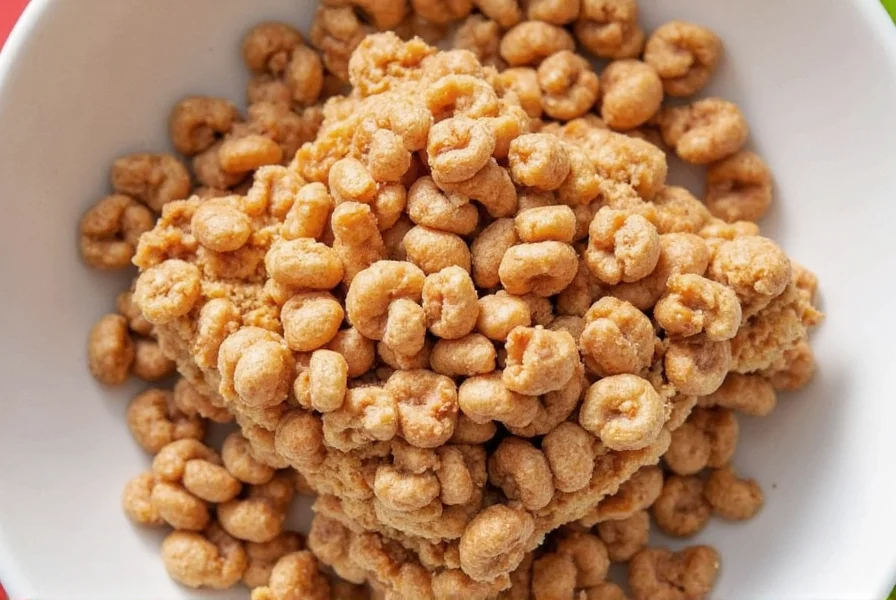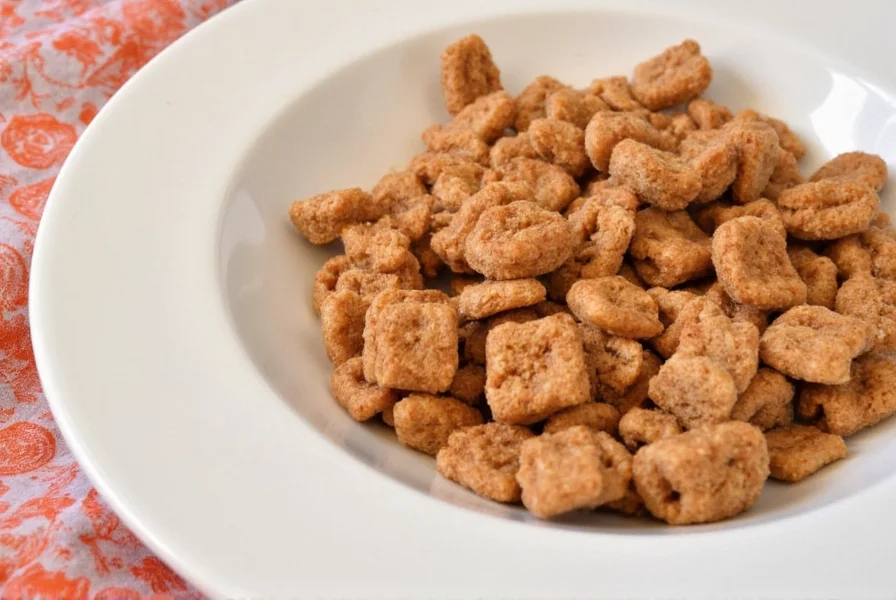When shoppers search for cinnamon toast cereal, they're almost always looking for the beloved Cinnamon Toast Crunch brand. This iconic breakfast staple has been a pantry favorite since its introduction in 1985, offering that distinctive sweet cinnamon flavor in every bite. Understanding what makes this cereal special requires examining its unique composition, flavor profile, and how it differs from both homemade cinnamon toast and other cereal options.
Understanding Cinnamon Toast Cereal: More Than Just a Name
The term "cinnamon toast cereal" creates some confusion in the grocery aisle. While it sounds like it could describe any cereal with cinnamon toast flavoring, in reality, it's become synonymous with Cinnamon Toast Crunch. This branding phenomenon demonstrates how successful marketing can shape consumer language. The cereal's square "crunchers" with their signature cinnamon-sugar coating deliver that nostalgic toast flavor without the need for actual bread.

Product Characteristics and Composition
Cinnamon Toast Crunch stands out from other breakfast cereals through several distinctive features:
- Unique shape: Square "crunchers" rather than traditional O's or flakes
- Flavor delivery system: "Crunch berries" concept where the flavor intensifies as you eat
- Texture profile: Crispy exterior with slightly chewy interior when fresh
- Sugar content: Approximately 9 grams per 3/4 cup serving
The cereal's ingredient list reveals why it tastes so much like cinnamon toast: whole grain rice, sugar, rice flour, and a proprietary blend of cinnamon and other flavorings. Unlike actual cinnamon toast made from bread, this cereal provides consistent flavor in every bite without the need for toasting or butter.
Nutritional Profile Compared to Alternatives
Understanding cinnamon toast cereal nutrition facts helps consumers make informed choices. A standard 3/4 cup (29g) serving contains:
| Nutrient | Cinnamon Toast Crunch | Regular Toast with Cinnamon | Basic Corn Flakes |
|---|---|---|---|
| Calories | 120 | 70-100 | 100 |
| Total Fat | 1.5g | 1-3g | 0g |
| Carbohydrates | 25g | 15-20g | 24g |
| Sugar | 9g | 5-8g | 2g |
| Fiber | 1g | 1-2g | 1g |
While cinnamon toast cereal ingredients include added sugar for that signature taste, it does provide some whole grains and is fortified with essential vitamins and minerals. The cereal contains 45% of the daily value for iron and various B vitamins per serving.
Cinnamon Toast Crunch vs. Homemade Cinnamon Toast
Many consumers wonder is cinnamon toast cereal the same as cinnamon toast crunch. The answer is yes—Cinnamon Toast Crunch is the specific branded product that defines what most people mean by "cinnamon toast cereal." However, it's different from actual cinnamon toast made from bread:
- Convenience: Ready to eat immediately with milk, no preparation needed
- Consistency: Uniform flavor and texture in every serving
- Portability: Easy to take on-the-go compared to toast
- Shelf life: Stays fresh for weeks when properly stored
For those seeking a healthier alternative, some consumers create how to make cinnamon toast cereal at home versions using toasted whole grain cereal squares with cinnamon and a light sugar coating, though these rarely match the distinctive texture of the commercial product.
Popular Variations and Limited Editions
General Mills has expanded the Cinnamon Toast Crunch line with several successful variations that address different consumer preferences:
- Apple Cinnamon Toast Crunch: Adds apple flavor to the classic recipe
- Whole Grain Cinnamon Toast Crunch: Higher fiber version with more whole grains
- Gluten Free Cinnamon Toast Crunch: For those with dietary restrictions
- Minis: Bite-sized version popular with children
- Seasonal varieties: Pumpkin Spice and other limited-time offerings
How to Enjoy Cinnamon Toast Cereal Beyond Breakfast
While most consumers eat Cinnamon Toast Crunch with milk for breakfast, its versatility makes it suitable for various applications. Understanding cinnamon toast cereal history reveals that General Mills designed it to capture the essence of a beloved snack in cereal form, which naturally lends itself to creative uses:
- Cereal snacks: Mix with nuts and dried fruit for a sweet trail mix
- Baking ingredient: Use as a topping for fruit crisps or crumbles
- Yogurt topper: Adds crunch and flavor to plain yogurt
- Ice cream topping: Pairs perfectly with vanilla ice cream
- Cereal bars: Bind with honey for homemade snack bars
Consumer Reception and Cultural Impact
Cinnamon Toast Crunch has maintained strong popularity since its 1985 debut, becoming one of General Mills' most successful cereal innovations. Market research indicates consistent top-10 positioning among children's cereals in the United States. The brand's memorable advertising campaigns featuring the "Crunch Crew" characters have contributed significantly to its enduring appeal.
When examining cinnamon toast cereal history, we see how it capitalized on the universal appeal of cinnamon toast while solving the practical challenges of turning this snack into a shelf-stable breakfast option. Unlike actual cinnamon toast that requires preparation, this cereal delivers the flavor experience with minimal effort—simply add milk.
Frequently Asked Questions
Is cinnamon toast cereal the same as Cinnamon Toast Crunch?
Yes, when people refer to "cinnamon toast cereal," they almost always mean Cinnamon Toast Crunch, which is the branded product made by General Mills. The term has become synonymous with this specific cereal despite technically describing a flavor concept.
What are the main ingredients in cinnamon toast cereal?
The primary ingredients in Cinnamon Toast Crunch include whole grain rice, sugar, rice flour, salt, and a cinnamon flavor blend. It also contains natural and artificial flavors, as well as vitamins and minerals for fortification. The distinctive taste comes from the specific cinnamon-sugar coating on each piece.
How does cinnamon toast cereal differ from actual cinnamon toast?
Cinnamon toast cereal (Cinnamon Toast Crunch) differs from actual cinnamon toast in several ways: it's made from rice rather than bread, has a consistent square shape, contains added vitamins and minerals, and delivers uniform flavor throughout without requiring preparation. The cereal provides the cinnamon toast flavor experience in a convenient, shelf-stable format that maintains crunch when milk is added.
Are there healthier alternatives to traditional cinnamon toast cereal?
Yes, General Mills offers a Whole Grain version with more fiber and slightly less sugar. Some consumers create homemade versions using toasted whole grain cereal squares with a light cinnamon-sugar coating. For those seeking lower sugar options, you could use regular whole grain cereal and add a small amount of cinnamon and minimal sugar yourself.
What are the most popular variations of cinnamon toast cereal?
The most popular variations include Apple Cinnamon Toast Crunch, Whole Grain Cinnamon Toast Crunch, Gluten Free Cinnamon Toast Crunch, and Cinnamon Toast Crunch Minis. Seasonal varieties like Pumpkin Spice have also gained popularity during fall months. Each variation maintains the core cinnamon toast flavor while introducing new elements or addressing specific dietary needs.











 浙公网安备
33010002000092号
浙公网安备
33010002000092号 浙B2-20120091-4
浙B2-20120091-4